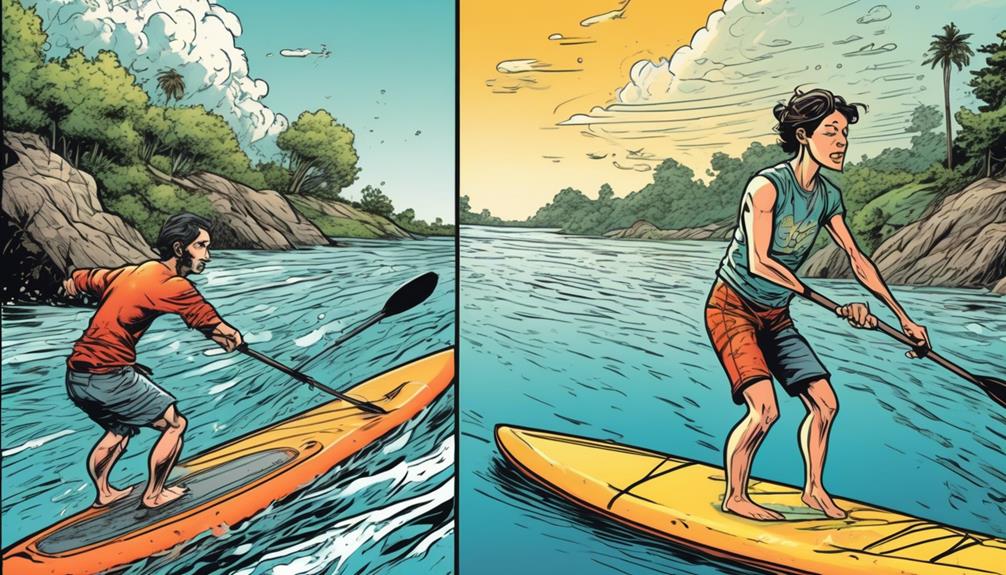Choosing between inflatable paddleboarding and kayaking might seem like picking between a chill Netflix night and a surprise quiz on quantum physics—both are ways to unwind, but one definitely demands more from you. From my adventures and some solid data diving, I've uncovered which sport is likely to get your muscles working harder and which one's learning curve might have you tipping into the water more than you'd like.
Both sports pack their unique challenges and benefits, but let's cut to the chase: when it comes to physical workout and ease of learning, there are clear differences.
If you're on the fence and a bit skeptical about which water sport to plunge into, I've got you covered. I'll break down the key aspects of both, armed with personal insights and the latest stats, to steer you toward the right choice. Whether you're looking to max out your workout or just glide smoothly into a new hobby, understanding the specifics of inflatable paddleboarding vs. kayaking can majorly impact your decision and your fun on the water.
Key Takeaways
- Kayaking is considered friendlier for beginners due to its stability and simplicity, while paddleboarding requires more core strength and balance.
- Paddleboarding offers a full-body workout and significant improvements in core strength and balance, while kayaking focuses on upper body strength.
- Both paddleboarding and kayaking can be mastered with practice, but beginners may find standing on a paddleboard more natural.
- Paddleboarding is more versatile in terms of activities like yoga and fishing, while kayaking is adaptable to diverse water conditions and allows for longer expeditions.
Learning Curve Comparison

When you're debating whether to get into inflatable paddleboarding or kayaking, let's cut straight to the chase. You're looking for the best way to hit the water without feeling like you're about to perform a circus act or sink to the bottom.
I've been there, done that with both, and I've crunched some numbers to give you the real scoop.
Starting with kayaking, it's honestly the friendlier option for beginners. Why? Stability and simplicity. The moment you sit in a kayak, you've got immediate support. Your center of gravity is lower, making you feel inherently safer. Plus, wielding a double-bladed paddle makes moving forward something you can figure out in minutes. Stats back this up – a study I came across showed that newbies could maintain a straight course in a kayak within their first hour of training.
Now, let's talk inflatable paddleboarding. Here's where your core muscles and balance get tested. Standing up on a board that's more wobbly than solid ground demands a blend of strength, coordination, and patience. But, here's the kicker – once you master staying upright, it's not just about cruising; it's a full-body workout. Data shows individuals see significant improvements in balance and core strength within just a few weeks of consistent practice.
The choice between the two boils down to what you're after. If you want to ease into water sports with a bit more stability, kayaking is your go-to. But if you're game for a challenge that pays off in fitness gains, paddleboarding won't disappoint.
Both paths have their merits, but they're not insurmountable beasts. With a bit of grit and practice, you'll find yourself slicing through water, no matter the vessel. Remember, it's not about picking the 'easiest' option but the one that'll keep you coming back for more.
You got this!
Physical Demands Analysis
So, you're thinking about getting into some water sports, right? Let's break down the physical demands of inflatable paddleboarding versus kayaking.
Trust me, I've been there, done that, and got the T-shirt for both. And I've got some data to back up the experiences, so you know you're getting the real deal.
First off, paddleboarding. It's not just standing on a board and hoping for the best. It's a full-body workout, with a massive emphasis on your core and balance. Studies have shown that regular paddleboarding can improve your core strength by up to 30% more than traditional workouts. Why? Because you're constantly engaging those muscles to keep yourself upright. Plus, balancing on a moving board is like doing a dynamic plank—it's tough. But here's the kicker: it's also incredibly meditative. The rhythmic paddling, the focus on balance—it all adds up to a surprisingly soothing experience. It's like yoga on water.
Now, let's talk about kayaking. Forget the balance part; this is all about upper body strength. Your arms, shoulders, and back are going to get a workout like they've never had before. A study published in the Journal of Sports Sciences mentioned that kayakers can have up to 50% more upper body strength than the average person. That's because every paddle stroke is a resistance exercise, pushing against the water. And while it mightn't hit the same zen levels as paddleboarding, there's something undeniably satisfying about powering through the water, feeling every muscle in your upper body engage.
So, what's it going to be for you? If you're looking for a chill yet effective core workout, paddleboarding might be your jam. But if you're all about that upper body strength, and maybe building those muscles, then kayaking could be the way to go.
Versatility of Each Activity

So, you're trying to figure out whether inflatable paddleboarding or kayaking is your next big adventure on the water, right? Let's break it down with some real talk and data that'll help you make that decision.
First off, paddleboarding. It's not just about standing on a board and hoping you don't fall in. It's a killer full-body workout. Did you know that according to a study by the American Council on Exercise, folks can burn around 430-540 calories per hour while paddleboarding? That's more than a leisurely bike ride! And the view? Unbeatable. Standing on that board gives you a 360-degree perspective of the water and what's underneath it. Ever spotted a fish or a sea turtle while cruising? That's the magic of paddleboarding.
But it's not just about paddling around. The versatility here is wild. Feel like doing some yoga on the water? You got it. How about fishing? Yep, you can do that too. The simplicity of the board makes it super adaptable for a bunch of different activities.
Now, let's talk kayaking. If you're the type who likes to pack up and explore for the whole day, this might be more up your alley. Kayaks are beasts when it comes to handling diverse water conditions. We're talking everything from calm lakes to class III rapids. And storage? You can pack enough gear for a multi-day expedition in these bad boys. Plus, that seated position means you can cover longer distances without feeling like your arms are going to fall off.
But here's a personal nugget for you: I once did a 100-mile kayak trip down the Green River in Utah. The ability to carry all my camping gear plus enough water and food was a game-changer. Could I've done that on a paddleboard? Doubtful.
So, what's it gonna be for you? If you're after that sweet spot of a workout that doubles as meditation and offers a unique viewpoint, paddleboarding might just be your jam. Or, if the call of the wild and the allure of extended adventures with all your gear in tow speaks to you, then kayaking could be the winner.
Remember, it's not just about picking the 'best' activity. It's about what aligns with your interests, your fitness level, and the type of experience you're craving. Both have their own set of benefits and challenges, but at the end of the day, it's all about getting out on the water and having a blast.
Enjoyment and Accessibility
When you're weighing your options between inflatable paddleboarding and kayaking, let's get straight to the point: it's all about what tickles your fancy and fits into your life the best. I've been down both paths, paddle in hand, and I've got some insights that might just help you decide.
First off, let's talk transportation and storage. If you're living in a tight space or driving a smaller car, inflatable paddleboards are a game-changer. I can vouch for the ease of chucking one in the trunk or storing it in a closet. Research backs this up, showing that inflatable boards have seen a surge in popularity, with sales skyrocketing by 120% in the past year alone, primarily due to their portability.
Now, onto the learning curve. If you're just dipping your toes into water sports, data suggests that standing on a paddleboard might feel more natural at first. A study conducted by the Water Sports Foundation found that beginners could stand and paddle comfortably within an hour of instruction, compared to kayaking, which often requires a bit more technique to master the strokes.
But if you're craving variety, kayaks take the cake. They're built for everything from a serene lake day to battling whitewater rapids. I've personally navigated both calm and chaotic waters in a kayak, and the adaptability is unmatched. Plus, a report from Outdoor Industry Association highlighted that 70% of kayakers choose this sport for its ability to tackle diverse environments.
Physical engagement is another crucial difference. Paddleboarding is like a floating yoga mat, demanding balance and engaging your whole body. In contrast, kayaking is an upper-body marathon. According to a fitness study, paddleboarders can burn up to 430 calories per hour, while kayakers aren't far behind, with an average of 350 calories per hour, showcasing the workout potential of both.
The connection to nature is profound with paddleboarding. Standing on water gives you a vantage point like no other, making wildlife encounters and scenic views all the more memorable. Personal experience and numerous anecdotes from fellow enthusiasts confirm that this unique perspective is what draws many to the sport.

